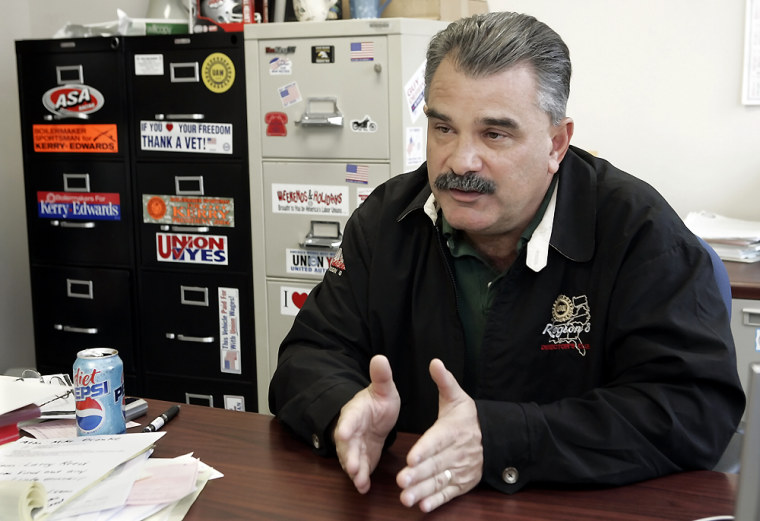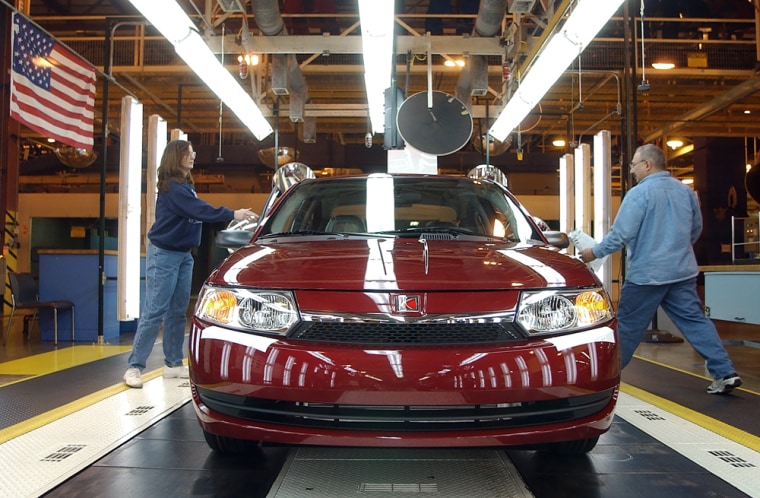When General Motors Corp. started building cars in this sleepy farming town nearly 15 years ago, the Saturn plant was touted as a key component of the automaker’s vision for the future.
But now this thriving Nashville suburb finds itself recast as another in a long list of Rust Belt survivors — worried about its economic future as GM announces it will eliminate 30,000 manufacturing jobs, including a production line in Spring Hill where the Ion compact car is produced. Other communities in Oklahoma, Georgia, Michigan and Canada are also facing a future without GM jobs.
“You hate to see jobs go,” Spring Hill Mayor Danny Leverette said. “That’s where my heart is — first and foremost with the employees. GM is in some tough times now, but I remain an optimist.”
Neither union nor GM officials are specifying how many jobs could be lost when the Saturn lon production line shuts down in 2006. But any layoffs would be the first at Spring Hill, which GM thrust into the spotlight 20 years ago when it announced it was creating a new kind of car division that could better compete with low-cost imports from Toyota, Honda and Nissan.
The plant, where a separate line will remain open for the assembly of Vue SUVs, employs about 5,700 and is one of the state’s largest employers.
Saturn once billed itself as “a different kind of company” making “a different kind of car,” but after a promising start, Saturn let the car’s look and technology get stale. New models were finally introduced, but to mixed results. The Ion production line was shut down for at least 15 weeks in 2004 as sales failed to meet the company’s expectations.
Monday’s news about plant closings left employees stunned at GM’s Oklahoma City assembly plant, where the midsize Chevrolet TrailBlazer and GMC Envoy SUVs are produced. Two thousand hourly and 200 salaried employees will be out of work by 2006.

Warren Evans, a GM employee at the Oklahoma City plant since 1983, said he and many workers at the plant were skeptical of GM’s decision to retool the plant several years ago. “When they put this new product in there, the SUV, I knew it wasn’t going to work out,” he said. “The market was already flooded with the SUVs.
“The engineers, to me, they’re stuck on stupid. They never talk to us, the people on the line.”
At other GM sites where cuts were announced, employees knew reductions were in the works but faulted the company for short notice of the decisions.
Some union leaders in the Lansing, Mich., area, where GM has been a dominant presence for years and about 1,400 jobs are expected to be lost, said they received just 10 minutes’ notice that one of their parts factories was targeted for closure next year.
“We’re shocked,” said Chris Sherwood, president of United Auto Workers Local 652, which represents about 1,000 workers at a GM metal center in Ingham County’s Lansing Township. “We thought we had a pass on this round. But we didn’t.”
The Michigan losses include 400 at GM’s Craft Centre, where workers build the slow selling Chevrolet SSR two-seater truck. That plant is slated to close in mid-2006, followed by a parts processing operation in Ypsilanti in 2007 and an engine facility in Flint that makes the 3800-series engine in 2008.
“It’s kind of a sad day for a lot of people,” said James Wells, 51, hours after learning his Lansing factory with an estimated 1,000 hourly workers would close next year. “But a lot of us could go to other plants. There are a lot of options.”
The Lansing area now has an estimated 6,500 GM jobs, about a third as many as during employment peaks in the 1970s and 1980s. But GM is building up a parts and vehicle assembly operation in nearby Delta Township, where some of the workers affected in the upcoming closings might find work. The automaker also opened a Cadillac assembly factory near downtown Lansing in recent years.
Canadian Auto Workers President Buzz Hargrove blamed imports from Japan and South Korea and protectionism by Asian governments for the loss of 3,600 jobs at plants in Oshawa and St. Catherines, Ontario.

Oshawa Car Plant No. 2, where Pontiac Grand Prix and Buick LaCrosse autos are assembled, will shut down after current production plans end in 2008. No new car models will replace that production, resulting in 2,750 job losses. GM will also remove the third shift at Oshawa Car Plant No. 1 which assembles the Chevrolet Impala and Monte Carlo in the second half of 2006, causing a reduction of 1000 jobs.
Ray Jenkins, mayor of Doraville, Ga., the Atlanta suburb where GM employs 2,900 at an assembly plant scheduled to close in 2008, said the city will survive the loss of its largest employer. “We’re working the best we can to put something back in there,” he said.
Models currently built at the Doraville plant include the Buick Terraza, Chevy Uplander, Pontiac Montana SV6 and the Saturn Relay.
At a nearby Waffle House restaurant, manager Tyriko Duckett says GM workers come in to fill up on hamburgers, steaks and pork chops before their shift begins. “I’m going to lose a lot of customers,” Duckett said. “They’re just like family.”
The 3,900 workers at GM’s oldest plant in Janesville, Wis., were among the most surprised that their facility wasn’t targeted. But spokeswoman Carolyn Markey said one reason may be the plant’s launch of the next line of the largest sport utility vehicles early next year, funded in part by $10 million in state-provided money for worker training.
Janesville employees have been trained to build the more fuel-efficient GMT-900 series, including Chevy Suburbans, Tahoes and GMC Yukons at the 86-year-old facility.
GM’s local payroll, at $225 million, accounts for more than 6 percent of local wages, and that left Angie Zahn, manager of the Citgo gas station next to the GM plant, thankful. “They go down, we go down,” she said. “This whole town would have turned into a ghost town.”
